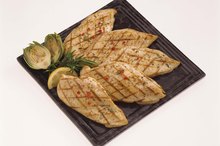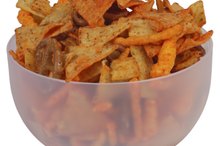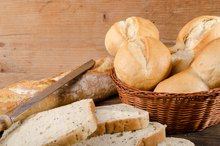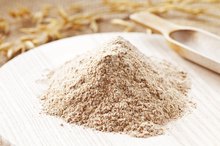What does fact checked mean?
At Healthfully, we strive to deliver objective content that is accurate and up-to-date. Our team periodically reviews articles in order to ensure content quality. The sources cited below consist of evidence from peer-reviewed journals, prominent medical organizations, academic associations, and government data.
The information contained on this site is for informational purposes only, and should not be used as a substitute for the advice of a professional health care provider. Please check with the appropriate physician regarding health questions and concerns. Although we strive to deliver accurate and up-to-date information, no guarantee to that effect is made.
Gluten-Free Mediterranean Diet
The Mediterranean Diet incorporates food and drinks traditionally served in Egypt, Greece, Italy, Turkey, France and other countries that border the Mediterranean Sea. Gluten refers to a group of storage proteins found in wheat, barley and rye that cause an autoimmune disorder known as celiac disease, or CD. While other grains like corn and rice also contain glutens, these glutens don’t cause CD. Because whole grains are an integral part of the Mediterranean Diet, it can be challenging to create gluten-free meals 1.
Identification
According to the Mediterranean Foods Alliance, the Mediterranean Diet incorporates significant amounts of whole grains, fruits and vegetables. People on this diet also eat moderate amounts of cheese and yogurt, select healthy fats such as those found in olive oil and nuts, eat fish and seafood regularly and drink wine in moderation.
Gluten-Free Components
Foods Containing Gluten & Gliadin Proteins
Learn More
Fresh, unprocessed fruits, vegetables, dairy products meat/meat alternatives are gluten-free, according to the University of Chicago Celiac Disease Center. Other gluten-free components of the Mediterranean diet include nuts, wine without preservatives or added dye and fresh, frozen, dried or canned vegetables and fruits without thickening agents 1. Aged hard cheeses like cheddar, Swiss, Edam and Parmesan are gluten-free. Yogurt, olive and canola oil are also gluten-free, according to the Celiac Sprue Association.
- Fresh, unprocessed fruits, vegetables, dairy products meat/meat alternatives are gluten-free, according to the University of Chicago Celiac Disease Center.
Forbidden Foods
The emphasis on whole grains in the Mediterranean Diet can create challenges for gluten-sensitive individuals. While whole grains like wheat and barley are obvious sources of forbidden gluten, it’s also important to avoid flours made from derivatives of those grains, including bulgur, durham, farina, graham, matzo meal and semolina. Many commercially-prepared foods like breads, cakes, pies, cereals, cookies, crackers and pasta are gluten-laden, says MayoClinic.com 1. Condiments like salad dressing, sauces and gravy may use gluten as a thickener.
- The emphasis on whole grains in the Mediterranean Diet can create challenges for gluten-sensitive individuals.
- While whole grains like wheat and barley are obvious sources of forbidden gluten, it’s also important to avoid flours made from derivatives of those grains, including bulgur, durham, farina, graham, matzo meal and semolina.
Substitutes
Low Glycemic & Gluten-Free Foods
Learn More
The Celiac Sprue Association recommends a number of grains and starches to replace those derived from wheat, rye or barley. People on the Mediterranean Diet who are gluten-sensitive can safely eat white or brown rice flour, potato, tapioca, arrowroot, corn meal, corn flour, soy flour, flax, wild rice, quinoa, millet, hominy and flours that are labeled 100 percent gluten-free 1. When purchasing a new product, it’s important to read the label carefully to make sure gluten was not added during the manufacturing process.
Tips
The Celiac Sprue Association publishes an extensive listing of gluten-free grains and flours that can guide people who want to stick with the Mediterranean Diet 1.
Related Articles
References
- MayoClinic.com: Gluten-Free Diet
- Celiac Disease Foundation. 9 Things You Should Know Before Going Gluten-Free. Published February 12, 2014.
- U.S. News & World Report. Best Diets Overall. Published Jan. 2, 2020.
- Morreale F, Agnoli C, Roncoroni L, et al. Are the dietary habits of treated individuals with celiac disease adherent to a Mediterranean diet?. Nutr Metab Cardiovasc Dis. 2018;28(11):1148-1154. doi:10.1016/j.numecd.2018.06.021
- U.S. News & World Report. Vegetarian Diet. Published Jan. 2, 2020.
- University of Virginia Health System. Low FODMAP Diet. Updated December 2016.
- Priyanka P, Gayam S, Kupec JT. The Role of a Low Fermentable Oligosaccharides, Disaccharides, Monosaccharides, and Polyol Diet in Nonceliac Gluten Sensitivity. Gastroenterol Res Pract. 2018;2018:1561476. doi:10.1155/2018/1561476
- Thirty & Co, LLC. The Whole30 Program Rules.
- Roncoroni L, Elli L, Doneda L, et al. A Retrospective Study on Dietary FODMAP Intake in Celiac Patients Following a Gluten-Free Diet. Nutrients. 2018;10(11). doi:10.3390/nu10111769
- Rostami K, Bold J, Parr A, Johnson MW. Gluten-Free Diet Indications, Safety, Quality, Labels, and Challenges. Nutrients. 2017;9(8). doi:10.3390/nu9080846
Resources
Writer Bio
Sandy Keefe, M.S.N., R.N., has been a freelance writer for over five years. Her articles have appeared in numerous health-related magazines, including "Advance for Nurses" and "Advance for Long-Term Care Management." She has written short stories in anthologies such as "A Cup of Comfort for Parents of Children with Special Needs."









